 Book Club
Book Club
The Messy Business of Reclamation
This month we hiked along a river reclaimed. Just a few decades ago, the Middle Fork Snoqualmie River was a dumping ground for all things expensive to dispose of: old campers, cars, trucks, construction materials, appliances, tires, etc. That changed when a community-wide effort launched to clean up the area and restore it to its natural state in the late 1990’s. A coalition of volunteers spent years cleaning up the valley and looking out into the crystal clear water today, you would have no idea of its storied past.

It’s hard to argue that these extraordinary efforts were not worthwhile. But, as we learned in our March book selection, Reclaimers, reclamation is not always so black and white as good or bad, beneficial or detrimental. Even the definition of the word is not entirely clear and seemingly contradictory.
Reclaim:
1. to recall from wrong or improper conduct
2. to rescue from an undesirable state; also: to restore to a previous natural state <reclaim mining sites> b: to make available for human use by changing natural conditions <reclaim swampland>
How can reclamation mean both restoring to a natural state and to make available for human use at the same time? And what does improper conduct and undesirable state really mean? Ana Maria Spagna went looking for these answers by traveling back and forth, up and down the west coast from Seattle to northern California in her aging Buick. She met some incredible people (mostly women) who were fighting long, hard battles to reclaim just a little bit of land that nourished their people for thousands of years. These were the Timbisha Shoshone whose ancestral land was in the middle of Death Valley National Park, and the Mountain Maidu who reclaimed the sacred Humbug Valley near Mt Shasta from a large energy company.

Where is the moral high ground? And who decides? Judgments cycle. Fire is bad, fire is good. Predators are bad, predators are good. And with the judgments, so go our actions: Put out fires, start prescribed fires. Eliminate predators, reintroduce predators. Like Sisyphus on a hamster wheel.
Where is the moral high ground? And who decides? Judgments cycle. Fire is bad, fire is good. Predators are bad, predators are good. And with the judgments, so go our actions: Put out fires, start prescribed fires. Eliminate predators, reintroduce predators. Like Sisyphus on a hamster wheel.

Much of the book is also focused on rivers and dams. Recently, there has been much effort taken to remove dams that are not useful or are harmful to fish, such as on the White Salmon river and the Elwha River. But is it always best to remove the dams? My gut reaction is to say yes, but as I learned from this book, the best solution is far from clear. Ana describes this dilemma as hammering a nail into a tree and then pulling it out. The hole is still there. With dam removal comes careful monitoring to get the right amount of sediment and the proper reintroduction of fish. There is so much focus and energy spent on how to perfect the conditions to return to some original state. Is it possible to think we could just make the dams better for fish?

…the lesson I kept relearning about reclaiming is that it’s not about what we’ve lost, how to retrieve or re-create it, but how best to move forward.
…the lesson I kept relearning about reclaiming is that it’s not about what we’ve lost, how to retrieve or re-create it, but how best to move forward.

It’s not about what we’ve lost, but how best to move forward. This quote is what will stick with me most from the book. We must get away from the ideals of “returning” land to untouched, pristine wilderness. These romantic notions are naive and it devalues the contributions and knowledge of the Native American people. Rather, we should learn from them and take note of their traditional land management practices that sustained people for thousands of years without depleting or destroying natural resources. And then, with much debate and thought, maybe we can work together to find better solutions.

I would love to hear your thoughts about the book and the idea of reclamation. Have you, like me, struggled to find a balanced opinion regarding these issues? Do you agree with Ana’s conclusions in the book?

Reclaimers by Ana Maria Spagna
Book Ends
- Read The Timbisha Shoshone of Death Valley and the Shadow of Trump in The New Yorker
- Watch this Spectacular Time Lapse Dam Removal video from National Geographic
- Support Friends of the Trail or volunteer to keep the Middle Fork Snoqualmie River valley healthy


































 Photo: Laura Norsen
Photo: Laura Norsen



















































